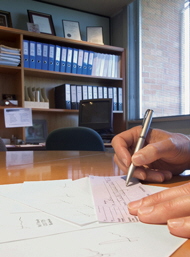
Take Action to Minimize Check-Fraud Risk
Frank Abagnale, a nationally known consultant on check and document fraud, has called check fraud “the safest crime to commit in America.” It doesn’t involve guns or violence, enforcement is lax and rarely do perpetrators go to prison, he says.
It may be safe for criminals, but check fraud is causing some serious “injuries” for businesses, whose losses and liability related to this crime have continued to climb.
In recent years, desktop publishing equipment has made counterfeiting easier and more accessible. All a criminal needs to produce high-quality counterfeit checks is a personal computer, a scanner and a high-resolution laser printer or color copier. As a result, the federal government says more than 1.2 million fraudulent checks are written every day, and most estimates peg total annual check-fraud losses at somewhere above $10 billion.
Changes made to the Uniform Commercial Code in the 1990s require businesses to take proactive steps to prevent fraud. Companies face increased liability when they are in a position to prevent check-fraud losses and fail to take any action.
Positive Pay, Cole Taylor’s reconciliation product, is an effective deterrent to check fraud. Companies using this service send Cole Taylor an electronic check issue file that is then matched against a file of checks presented for payment on the company’s account. When an item doesn’t match, Cole Taylor refers it to the client within the return-item timeframe for a pay/no pay decision.
Beyond utilizing Positive Pay, experts suggest that companies can take a number of steps to minimize the risk of check fraud. Some important best practices include:
Purchasing high-security checks. Safety features such as watermarks, microprinting, dual imaging and warning bands complicate the criminal’s task and act as a deterrent. Use checks with at least seven security features.
Maintaining tight check security. Store checks, check reorder forms, cancelled checks and signature stamps under lock and key.
Reconciling bank statements immediately upon arrival. The Uniform Commercial Code requires you to reconcile your bank statements within a reasonable time and report unauthorized checks immediately.
Separating financial duties within your organization. Individuals responsible for issuing checks should not be allowed to reconcile or have access to bank statements until after they have been reconciled. Reconcilers should not be signers on the account.
Controlling accounts payable and payroll functions. In most cases, corporations are responsible for any unauthorized checks issued by a dishonest employee.
Taking precautions with manually issued checks. They should be laser-printed or typed using a fabric ribbon, which doesn’t allow ink to be lifted off with Scotch tape. Checks should not be hand-written.
Using electronic payment services. To reduce the number of checks your company issues, consider utilizing electronic payment services such as Automated Clearing House (ACH) for payroll, tax, trade and other payments, and wire transfers for large-dollar, time-sensitive transactions.
For more information on Positive Pay and how it can assist in combating check fraud, please contact Cole Taylor’s Cash Management team at (312) 442-5070.
More than 1.2 million fraudulent checks are written every day, and most estimates peg total annual check fraud losses at somewhere above $10 billion.
Visit us at
www.coletaylor.com
